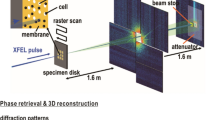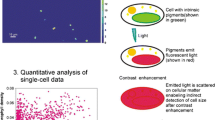Abstract
Polarization microscopy has been used to study the internal structures of microbial cells and in terms of the birefringence of these structures and its possible relation to the cell function and composition. Cyanobacteria of the genus Phormidium were found to contain no anisotropic structures, while other microorganisms were found to contain them, albeit to a different extent, size, and number. The flagellate Euglena was found to contain two large anisotropic bodies, whereas the flagellate of the genus Phacus belonging to the same systematic group Euglenales was observed to contain only one large anisotropic body (storage substances—paramylon). On the other hand, green algae of the genus Scenedesmus, whose cells form four-celled coenobia, contained clusters of small anisotropic granules composed also of storage substances (volutin). Minute anisotropic granules (storage substances) in two smaller clusters were found also in diatoms of the genus Navicula, whereas the green alga of the genus Mougeotia was revealed to contain, in addition to minute anisotropic granules (storage substances) occurring in low numbers in the cytoplasm, also a strongly birefringent cell wall (shape birefringence). Cells of the amoeba of the genus Naegleria and heliozoans of the genus Heterophrys were observed to contain only isolated tiny anisotropic granules (storage substances).







Similar content being viewed by others
References
Bouška O, Kašpar P (1983) Special optical methods (In Czech). Academia Praha
Canter-Lund H, Lund JWG (1995) Freshwater algae, their microscopic world explored. Biopress, Bristol
Graham EL, Wilcox LW (2000) Algae. Prentice Hall, Upper Saddle River
Heath JP (2005) Dictionary of microscopy. Wiley, Chichester
Hindák F (2008) Colour atlas of Cyanophytes. Veda, Publishing House of the Slovak Academy of Sciences, Bratislava
Gregorová M, Fojt B, Vávra V (2002) Microscopy of raw and technical materials (in Czech). Publishing House of Faculty of Science, Masaryk University Brno
Inoué S (2011) Lighting the way in microscopy. J Cell Biol 194:810–811
Prosser V (1989) Experimental methods of biophysics (in Czech). Academia, Praha
Patterson DJ (2003) Free-living freshwater protozoa. A color guide. AMS, Washington
Wolf J (1954) Microscopical technique (in Czech). State Health Publishing House, Praha
Wolowski K, Hindák F (2005) Atlas of Euglenophytes. Publishing House VEDA, Bratislava
Žižka Z (2012) Simple sets for digital microphotography used and tested in the study of microorganisms. Folia Microbiol 57:509–512
Acknowledgments
This work was supported by Internal Project RVO 61388971 (Institute of Microbiology Academy of Sciences of the Czech Republic, v.v.i., Prague).
Author information
Authors and Affiliations
Corresponding author
Rights and permissions
About this article
Cite this article
Žižka, Z. Anisotropic structures of some microorganisms studied by polarization microscopy. Folia Microbiol 59, 363–368 (2014). https://doi.org/10.1007/s12223-014-0307-5
Received:
Accepted:
Published:
Issue Date:
DOI: https://doi.org/10.1007/s12223-014-0307-5




